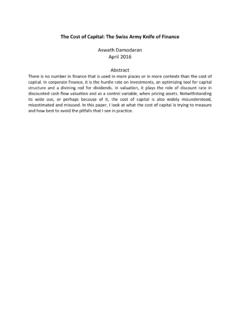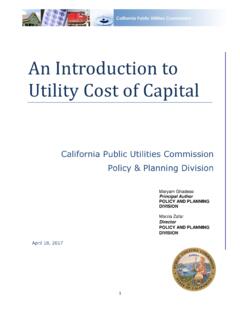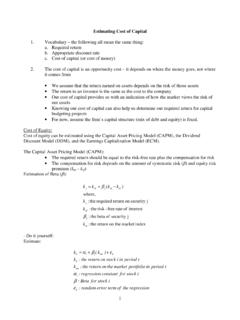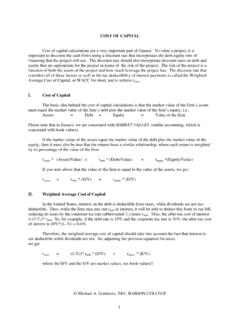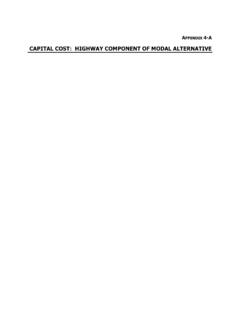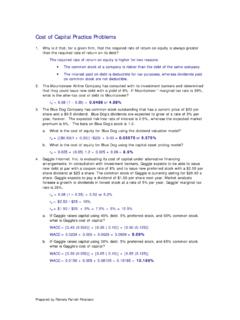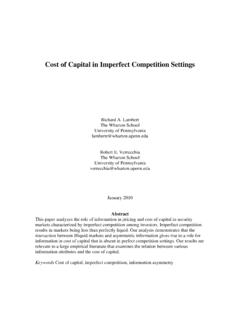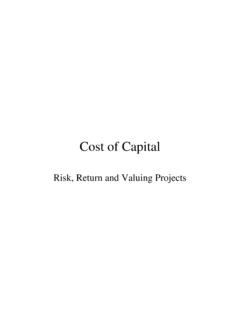Transcription of COST OF CAPITAL - University of South Florida
1 cost of CAPITAL 1 cost OF CAPITAL (Chapter 11) The major theme of the last few sections of notes has been valuation that is, the time value of money concepts provides you with the computations to determine the value of any asset; the valuation section showed you how to determine the value of financial assets, such as bonds and stocks; and the CAPITAL budgeting section showed how to determine whether an asset is an acceptable investment for the firm, which entails comparing the value of the asset to its cost (initial investment). To compute the value of an asset, you need to know the rate of return, r, that is required to invest in the asset. To this point, we have not discussed how the required rate of return is determined. The purpose of this section is to show you how the required rate of return for a firm (or for an individual for that matter) is determined and what the value for the required rate of return means.
2 As you read this section, keep in mind that the reason a firm has to earn a particular rate of return on its assets is because investors who provide funds to the firm demand to receive a return on their funds. As a result, the firm must earn enough on its investments to provide the return investors demand that is, r, or the required rate of return. The concept is the same as if you borrow money for the purposes of investing in the stock market. If your investments don t earn a return that covers the interest you are paying on the loan, which is your required rate of return in this case, then you lose money that is, the net present value (NPV) of the investments is negative, which means you reduce your wealth. The Logic of the Weighted Average cost of CAPITAL a firm generally uses more than one type of funds to finance its assets, and the costs of, or the returns associated with, those funds usually are not the same.
3 For example, the existing assets of firm might be financed with some debt, which has a market return ( cost ) equal to 8 percent, and with some stock, or equity, which has a market return ( cost ) equal to 15 percent. If 50 percent of the firm s financing is debt, then the other 50 percent is equity. Thus, 50 percent of the funds the firm is using costs 8 percent while the other 50 percent costs 15 percent, and the average rate that the firm is paying is 11 percent, which is the weighted average of the two costs (11 % = 8% + 15%). Basic Definitions o CAPITAL refers to the long-term funds used by a firm to finance its assets. o CAPITAL components the types of CAPITAL used by a firm. Generally, we include various kinds of debt, such as bonds, and equity, both preferred and common, in the CAPITAL of the firm. o cost of CAPITAL the cost associated with the various types of CAPITAL used by the firm. Each type of CAPITAL that is, each component has a cost , which, as we will see, is based on the rate of return required by the investors who provide the funds to the firm.
4 O Weighted average cost of CAPITAL , WACC the average percentage cost , based on the proportion each component of the total CAPITAL , of all the funds used by the firm to finance its assets. o CAPITAL structure the mix of the types of CAPITAL used by the firm to finance its assets. For example, one firm s CAPITAL structure might consist of 40 percent debt and 60 percent common equity while another firm s CAPITAL structure might be 60 percent debt, 10 percent preferred equity, and 30 percent common equity. o Optimal CAPITAL structure the mix of CAPITAL that is, debt and equity that minimizes the firm s WACC, thus maximizes its value. At this point, we assume that the firm s CAPITAL structure is optimal. In the next section of notes, we will discuss some of the factors that need to be examined to determine the optimal CAPITAL structure for a firm. cost of CAPITAL 2 cost of Debt, rdT the after-tax cost of debt, which is designated rdT, is simply the yield to maturity (YTM) of the debt, which represents the bondholders required rate of return, stated on an after-tax basis: ()()dddTax savingsAfter-tax componentBondholders' required=- cost of debtrate of returnassociated with debt= r - r T = r (1-T) where rd is the required rate of return of investors who hold the firm s bonds and T is the marginal tax rate of the firm.
5 Remember from the notes titled Risk and Rates of Return that rd is the rate of return that investors demand (require) to invest in the firm s bonds. This rate is also referred to as the market return or the yield to maturity (YTM) on the bond. Thus, effectively, investors who are the participants in the financial markets determine the firm s cost of debt. This is also the case for the other component costs of CAPITAL that is, the cost of equity. Example: A firm is considering issuing a bond to raise funds to finance its assets. The bond will have a face value equal to $1,000, a coupon rate of interest equal to 11 percent with interest paid semiannually, and a 10-year life. The firm expects the market price of each bond in the issue to be $ If the firm s marginal tax rate is 40 percent, what is rdT for this bond? To determine the component cost of debt, first consider the fact that we know the following situation must exist: 122055551 055942 65111222ddd$$$,$.
6 Rrr=+++ ++ + Solving for rd gives us the YTM for this bond. Remember that you can solve for the YTM by using: (1) trial-and-error that is, plug in different values for rd until the right side of the equation equals $ ; (2) the TVM keys on your calculator input N = 20 (20 interest payments), PV = (market value), PMT = 55 (semiannual interest payment), and FV = 1,000 (maturity value), and then solve for I; or (3) a spreadsheet (see the section of the notes titled Risk and Rates of Return for an explanation). Whichever method you us, you should find rd/2 in the previous equation equals 6 percent. But, because this result represents a six-month rate of return, it must be annualized to be useful. In other words, the YTM = 12% = 6% 2 = rd. Because rd = YTM = 12% is computed without considering the fact that the interest the firm pays its bondholders is a tax deductible expense to the firm, rd represents a before-tax amount and it needs to be adjusted so as to represent the actual cost to the firm that is, the cost of the bond to the firm isn t really 12 percent.
7 As an example of the tax deductibility of interest, consider the fact that when you finance your primary residence, the interest paid on the mortgage is tax deductible. Suppose the interest rate on a $100,000 mortgage is 10 percent and the mortgage calls for only one payment at the end of each of the next 10 years. The mortgage payment each year will equal $16, (you should be able to compute this value using TVM techniques discussed in earlier sections). In the first year, the portion of this payment that represents interest is $10,000 = x $100,000; thus the remainder, $6, , represents repayment of the principal amount of the cost of CAPITAL 3 mortgage. Assuming you itemize your expenses when computing your taxes, this $10,000 interest is tax deductible, which means it reduces your taxable income by $10,000. If you are in the 30 percent tax bracket, this deduction reduces the amount of taxes you would otherwise have to pay by $3,000 = $10,000.
8 Consequently, in reality the government helped subsidize your mortgage, and your net interest expense actually is $7,000, which is the $10,000 interest you pay less the $3,000 tax savings. On an after-tax basis, then, the interest rate you pay on the mortgage actually is = = $7,000 $100,000 = 10% (1 - ). This logic just presented can be applied to the current situation to yield an after-tax cost of debt equal to = 12% (1 - ) = rdT. This is the cost of the debt issue to the firm. cost of Preferred Stock, rps as with debt, the cost of preferred stock is based on the rate of return required by the firm s preferred stockholders, which is determined by the market price of the preferred stock. Remember that the dividend associated with preferred stock is a perpetuity, which, as was noted in previous sections, can be valued as follows: psps0rDP= where Dps is the constant dividend paid to preferred stockholders and rps represents the rate of return investors require to purchase the preferred stock.
9 Thus, in general terms, the cost of preferred stock can be stated as follows: 001pspspsDDComponent costrof preferred stockNPP (F)= == where NP0 is the amount per share that the firm receives when issuing preferred stock. NP0 is the market price of the stock less expenses that are associated with issuing the stock, which are called flotation costs (designated F in the above equation). Therefore, NP0 = P0 Flotation costs = P0(1 F), where F is stated in decimal form. (Note: If there are flotation costs associated with issuing new debt, they should be considered by reducing the market value of the debt by the amount of the flotation costs.) Consider a firm that has preferred stock that is currently selling for $130 per share and pays a dividend equal to $ If it will cost the firm 5 percent to issue new preferred stock, the cost of preferred stock, rps is: % $ $) (130$ $rps=== = Notice that the final result is not adjusted for taxes.
10 When we compute the component costs of equity there is no adjustment for taxes because dividends (preferred or common) are not tax- deductible expenses for the firm. cost of CAPITAL 4 cost of Retained Earnings, rs this refers to the return that common stockholders require the firm to earn on the funds that have been retained, thus reinvested in the firm, rather than paid out as dividends. In this case, what we are saying is that the firm must earn a return on reinvested earnings that is sufficient to satisfy existing common stockholders investment demands. If this required return is not earned, then the stockholders will demand that the firm pay them the earnings in the form of dividends so that they can invest the funds outside the firm at a better rate. In essence, then, the common stockholders are telling the firm that if it cannot invest at some minimum rate of return, then the earnings should be paid out as dividends so that the investors can invest in alternatives of their choice.

